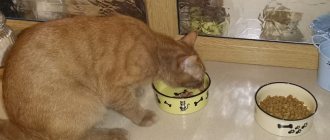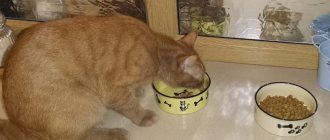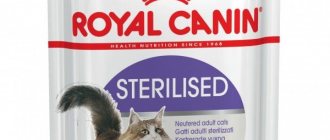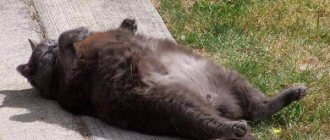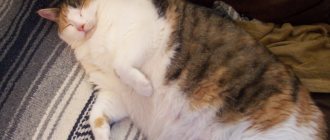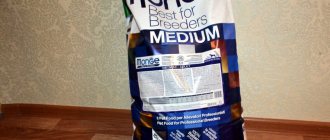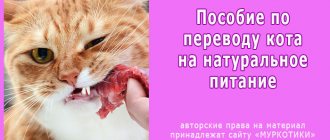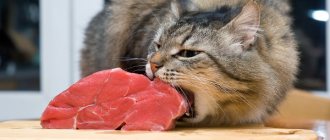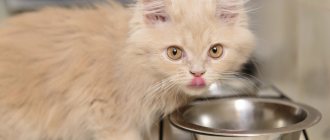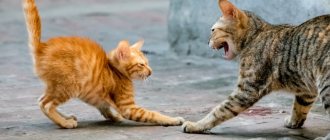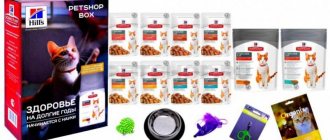When choosing the most optimal way to switch your cat to another food, you should not expect that she will immediately start eating it. Many mustachioed pets are picky eaters, especially at an older age, and suffer from food allergies and other diseases. But no matter for what reason the food changes: whether the kitten is growing up, the usual brand has disappeared from sale or has risen sharply in price, supply interruptions, only a gradual transition will provide a chance for success.
Why switch your cat to another food?
There are many reasons that guide owners when changing the animal’s usual diet, most often:
- any allergy or intolerance to some of the ingredients;
- age of the cat;
- lack of nutrients in the feed;
- the need for a special diet due to acute illnesses, pregnancy or obesity.
Proper nutrition plays an important role in the development of a pet - the well-being, activity and health of the pet depend on its quality. Therefore, you should not neglect the recommendations of a veterinarian who has advised you to change the animal’s diet, even if the cat categorically refuses new food.
Feed requirements
When choosing a new type of food for your domestic cat, you must adhere to the following requirements:
- composition and calorie content. The composition of new food products should include all micro- and macroelements, as well as vitamins that an animal of a particular age needs for growth and development;
- manufacturer. It is better to give preference only to well-known and time-tested manufacturers;
- shelf life;
- price. The owner should be able to purchase a new food format.
These are the basic requirements, but there are also additional ones (for example, taking into account the pet’s health status, individual intolerance to certain nutritional components, etc.).
Why do difficulties arise?
Any animal gets used to food. Especially if the cat has been given only one food for many months, and he has not seen any alternatives. You can’t come to an agreement with your pet, so you have to use tricks to accustom him to food that is unusual for him.
The unfamiliar texture, smell and taste of a new treat can cause a negative reaction in the animal. You will have to be patient and not give in to provocations: ignoring the bowl, “burying” granules of new food, loud meowing, meaning a demand to immediately fill the bowl with the usual food, “hungry eyes.”
Tips for feeding a cat you've recently adopted
Mixing food of different brands or formulations takes some time. Make sure your pet enjoys her meal.
- Prepare a private and quiet area for her to eat, without loud noises or other cats.
- Hand feed her, at least at first. The person offering the food must get along well with the cat.
- Offer wet or canned food along with dry food.
- Make sure you store all feed properly to maintain its quality and freshness.
Gradual translation
A smooth transition from one food to another is the most effective and safest method. The essence of this method is to gradually add new food to the old and mix them. This gradual transition may take about 10 days.
On the first day, you should mix the animal’s familiar and new food in a 3:1 ratio.
If everything in the bowl has been eaten, the next day you can increase the share of the new diet. By the fifth day, the amount of new food should be increased to 50%. After a week and a half, the cat will eat the new food with appetite, even if there is not a crumb of the old food on the plate.
It happens that the period of gradual transition is delayed: the animal eats the entire portion only if more than half of it is its favorite food, and when new food is added in larger quantities, it refuses to eat. This may indicate that the gentle technique is not suitable and other measures are needed.
When is a feed change recommended?
Cats, unlike humans, do not require variety in their diet. On the contrary, constant changes in diet and experiments adversely affect the health of a mustachioed pet.
It is only necessary to switch a cat to another food for several reasons.
The kitten has become an adult
Up to 1 year old, an animal is considered a kitten. It grows actively, so it needs a lot of calories. In addition, microelements and protein are necessary for growth, formation of the skeleton, teeth, etc.
If you continue to feed an adult cat (from a year old) with food selected for a kitten, this will lead to obesity and an excess of microelements, which in some cases is worse than their deficiency.
Elderly age
Veterinarians have noted that, starting from the age of 7 years, age-related changes occur: physiological processes slow down, body functions fade away. Felines' appetite and behavior change, and activity decreases. It is recommended to switch older animals to a new food for the elderly.
Ideally, a pet is switched to new food twice - when it grows up and when it gets old.
Pregnancy and feeding kittens
During the period of bearing offspring and feeding, the food should be temporarily changed back to high-calorie food. Therefore, pregnant and lactating cats are given balanced kitten food.
You can increase the portions or feed in small doses, but often, which is better. For a lactating cat, it is advisable to dilute dry food with water, which promotes milk production.
The mother cat is transferred to the previous diet for adults approximately 1.5-2 months after lambing. By this time, practically no milk is produced.
Obesity or excessive thinness
Excess weight and its deficiency are corrected by selecting food with a certain calorie content.
Abrupt transition
A diet change can be completed in as little as two days. This method is suitable for owners whose pets are very picky and, during the gradual transition, have learned to eat pellets of their usual food and leave the new one in a bowl. In this case, you will have to starve the cat out and give the cat a preventative one-day fast.
Fasting for 24 hours is a necessary measure. It is even beneficial for pets, especially sterilized ones, to occasionally go without food for a period of about one day - such fasting helps prevent obesity.
The essence of the method is extremely simple: you should remove the bowl for a day and not give the animal any food, including treats and treats from the table. It is important to leave a bowl with clean drinking water for your pet, otherwise preventive fasting will turn into real torture for your beloved cat. It can be very difficult to turn a blind eye to a cat’s requests (plaintive meow, sad look) to give you something from the table or return the bowl to its place, but you need to hold on and stand your ground.
The next day you should feed the cat new food. Experts advise leaving your pet alone at the bowl for the first meal - not standing over it, waiting for the cat to finally start eating, but behaving as usual.
If the animal refuses to approach unusual food, there is no need to panic. As a rule, the second day of hunger is much more difficult for the pet, therefore, realizing that he will not receive any other food today, he will eat everything that is on his plate with appetite. In cases where the cat continues to refuse food, you can extend the fast for no more than three days.
Switching from pates and pouches
Veterinarians criticize the mono-nutrition of pates and meat pieces from spiders, since such food softens the gums, increasing their bleeding and the likelihood of premature tooth loss. If you have accustomed your pet to such a diet, then it should be changed to mixed or dry.
Alternation method
This method does not involve a complete transition, but it allows you to reduce the amount of wet food in favor of dry food. Such nutrition has a beneficial effect on teeth, as it does not overload the gums and cleanses the enamel of tartar.
Here you can choose 2 options: alternate food by day or meal. For faster adaptation, the granules should be soaked in meat juice from wet canned food for the first time.
Mixing method
The mixing methods when switching from wet canned food to natural food are similar. The only difference is faster adaptation, the mandatory choice of one brand of products and careful adherence to the standards indicated on the packaging.
In most cases, cats get used to the new type of feeding within 7 days. For the first 2 days, it is better to serve the croquettes in crushed form, so that the mustachioed picky eater is not too outraged by the unusual consistency.
What else is important?
Even if you are switching your pet to a different diet for financial reasons, you cannot ignore the issue of quality. The diet of a carnivorous (domestic cat is a predator) animal must contain meat, which means the food must contain it. In addition, good food often contains probiotics, which are essential for the smooth functioning of a cat’s digestion, phytocomponents that help remove toxins, vitamins and minerals that help maintain the health of internal organs, softness and a healthy shine of the coat.
In the online store “World of Tails” you can choose the right food for your favorite cat; we offer a large selection of food for kittens, adult and elderly cats, from high-quality economy-class products to premium brands. The pet store offers brands Pro Plan, Royal Canin, Hill's, Trainer, Farmina and many other brands recommended by experts. In the catalog you will also find special food: veterinary, hypoallergenic and dietary food.
Reasons for changing your diet
The reasons why you need to switch your cat to a different diet may be the following:
- transition of an animal to another age group. A kitten, an adult cat and a cat or an already aging pet have their own nutritional requirements. Therefore, as your pet gets older, the need to change its diet will arise at least twice;
- cat pregnancy. In this state, the female needs more vitamins and nutrients into her body. Experts recommend switching pregnant cats to special food;
- postoperative recovery period (for example, after castration and sterilization). During rehabilitation, the risk of your pet gaining extra pounds increases. Therefore, veterinarians prescribe special food for animals;
- the pet has an individual intolerance to any product or component. This condition is characterized by the development of food allergies, which requires careful selection of food;
- disease. The disease weakens the pet, so he must follow a special diet prescribed by the veterinarian. In this case, independent selection of food is prohibited;
- Your pet's favorite food has been discontinued.
Some breeders recommend changing your cat's food 3 times a year to reduce the risk of developing food allergies. But if the animal feels normal and does not suffer from digestive disorders, then you can refrain from such actions.
Why is it so difficult to wean a cat off ready-made food?
The composition of dry food, especially the line of economy class products, includes a large number of attractants and additives - special ingredients designed to attract the animal, enhance the taste and smell of food, causing persistent addiction to such food. These components are mixed into all feed without exception, especially in super-economy class products. Cats almost immediately become addicted to drugs by eating such food.
The absence of useful components is hidden by manufacturers through the introduction of such chemicals. They significantly worsen the condition of the teeth and fur of pets, cause damage to the psyche, and cause serious illnesses and allergic reactions.
Important rules for transferring a pet to dry food from other types of food
When switching a cat to another type of food, you must follow several important rules:
- Taking into account the needs of the pet. The cat's preferences should be taken into account before offering another food. If your pet is a big fan of chicken, then it is unlikely that he will eat meat crackers. But indicating the type of meat on the package is not an advertising ploy, as many people think. A self-respecting manufacturer provides truthful information, which cannot be said about budget food. They use flavorings that are identical to natural ones. In addition, high-class industrial food is initially designed for the specific needs of the pet: to facilitate the removal of hairballs, for sterilized cats, for active cats. You should immediately take these nuances into account so that your pet receives a diet that suits its needs.
- Gradual means a gentle introduction of industrial feed into the diet.
A sudden change is harmful and even destructive. It is enough to replace 1/10 of the usual portion with “crackers” and increase it daily by 1/10. Every day you should replace only 1/10 of your pet’s usual diet with dry food. - Time. The transfer from one type of feed to another should be carried out within 10–14 days. During this time, the cat will already taste new food. After this time, only the industrial product should be in the bowl.
- Unobstructed access to water. This is the most important rule when feeding commercial food.
The nuances of switching to dry food from different diets
Depending on what the cat ate previously, there are some nuances when switching it to dry food.
From wet industrial food
If the cat ate canned food, that is, wet industrial food, then everything is simple. In the first 2-3 days, crackers must be pre-soaked to the desired consistency. Gradually, soaking can be replaced with light moistening with the sauce from these canned foods. That is, mix the granules into a bowl, let it brew, and then offer it to the cat. At the last step, you can simply stir in either just the sauce or just the pieces. And after complete adaptation, leave only dry food.
From natural homemade food
The same rule applies here as with wet food. But cats are very suspicious animals and can easily recognize deception. Experts recommend starting with mixing canned food into natural food, and only then switching from wet industrial food to dry food. By the way, it will take the same amount of time: about two weeks.
There is another, simpler way: offer a dry food pellet as a treat. And specifically for a hungry pet. If no problems arise, then pour the food into the bowl during feeding hours.
My mother decided to switch her cat to dry food. I bought him a pack of Royal Canin. But the pet did not appreciate the taste or smell of the new food at all - he simply buried it with his paw, twitched his tail and walked away. Mom tried to soak it and mix it in, but the cat had no intention of even trying the new treat. Then they bought him a banal “Friskies”. It was he who ate him by both cheeks. But, of course, you can’t feed an animal with this product all the time. The next experiment was with Purina Van food. It fit perfectly too. And finally, the final product in this chain was Purina ProPlan food. Both the owner and the pet settled on it; it suits them in all respects. So if your cat refuses dry food, he may simply not like the taste or smell of this product. And never buy large packs of expensive food at once - there is a chance that you will have to feed it to street cats.
In case of partial replacement of other feeds with dry food
Many cats are not particularly mischievous and happily eat both wet and dry food. This is quite normal, especially if there is only one manufacturer. As a rule, problems with replacement do not arise here. The owner should only strictly decide at what hours he feeds dry food and at what hours he feeds wet food.
What are artificial feeds?
There is also plenty written and said about artificial food for cats today. But basically this is a discussion about which food is better: premium or economy class? What is cheaper and what do cats eat better? The question of whether a cat needs to be fed artificial food at all is rarely raised.
Mostly canned food and dry food for cats are bought because we are lazy. Yes, yes, let's call a spade a spade. First of all, we take care of ourselves. When purchasing artificial food, we don’t bother ourselves with the question “what to give the cat for dinner.” I bought canned food, opened it, poured it into a bowl - and that’s it. Minimum expenditure of thought processes and time.
Natural food is healthier than artificial food.
Advertising of food also greatly contributed to their popularity and somewhat distorted our understanding of a cat’s diet. It is thanks to advertising that we know for certain that cats simply “need” cereals and other silage. But let me remind you that a cat is a carnivorous predator, which by definition cannot become a vegetarian.
In order to understand what ready-made food should consist of, you can remember what the menu of a cat in the village consists of (as close as possible to natural conditions). These are mainly small rodents, less often birds, and even less often fish and insects (moths and grasshoppers). All this is divided into:
- meat - animal proteins;
- bones and skin - calcium and phosphorus.
All that is contained in the victim's stomach is plant fibers and grains. Separately, cats eat grass occasionally for reasons of maintaining their health.
Cats do not eat fermented milk products on their own. Only as kittens in their cat childhood, and if a person allows it. Raw milk in the stomach of an adult cat almost immediately curdles and is not digested.
What follows from all of the above? The fact is that ideally the food should contain all these ingredients in natural proportions. Namely:
- meat – 45%;
- animal protein (egg or milk) – 20%;
- entrails, bones, offal – 10%;
- vegetable components (vegetables, cereals) – 20%;
- the rest is natural mineral supplements and vitamins – another 5%.
But, unfortunately, there are no ideal feeds. They would be too expensive and unprofitable to produce.
So what are we (or rather cats) offered as cheaper food to produce? In order not to be unfounded, we simply read what is written in small letters on a can or bag of food:
- chemical preservatives, sugar substitutes and antioxidants (you can’t live without them);
- by-products (good in principle, but who can guarantee that blood or feather meal, tails, sinews and other waste from slaughterhouses do not go there);
- dyes, flavor enhancers;
- fillers (cellulose, soy, starch).
If the presence of chemical components is at the very least reflected on labels, then with by-products and fillers it is somewhat more complicated. The legislation of many countries does not say at all that the manufacturing company is obliged to indicate a complete list of what is included in the by-products. And no one knows what may be hidden under this formulation.
Cats eat all of the budget line food with by-products of “plant and animal origin” with great appetite due to the presence of generously sprinkled flavoring additives. It’s hardly worth talking about their usefulness. Quite the contrary.
Cats get hooked on artificial food and then not only do they not eat anything other than dry food, but they also often have health problems:
- then the metabolism is disturbed, and cats become fat before our eyes;
- then tumors develop out of the blue;
- or even some British Vicomte de Bragelonne suddenly dies from liver or kidney failure due to many years of excessive consumption of food.
Sensitive stomach
You can understand that your pet has an overly sensitive stomach only after consulting a veterinarian. This must be done in order to differentiate hypersensitivity from food allergies or other diseases. Signs that your cat has a sensitive stomach and needs to change food are:
- eruption of gastric contents immediately after eating;
- disruption of the bowel movement in the form of constipation or diarrhea.
In addition to a sensitive stomach, the reason for changing food is the deterioration of the cat’s well-being. The owner may notice the appearance of an unpleasant odor from the animal’s mouth or tray. The causes of such symptoms are various pathologies, so it is important to give your cat a full examination at a veterinary clinic before changing food. Self-medication can be dangerous to the health of the animal.
Disadvantages of dry food in cat nutrition
Industrial feeds are addictive because they contain a large number of additives. Popular brands do not contain essential microelements; their minimal amount does not cover the damage to the digestive system caused by other ingredients. Long-term consumption of dry food leads to diseases of the digestive and genitourinary systems, stomach, and kidneys.
Causes and consequences of an inadequate cat diet
- Reason: High carbohydrate content in the feed. Consequences: Colic, bloating, ulcers, constipation, kidney failure.
- Cause: Insufficient fluid intake. Consequences: Constipation, kidney stones, kidney disease.
- Reason: Flavorings and flavoring additives in food. Consequences: Increased blood sugar levels and diabetes.
To normalize the functioning of internal organs, you need to feed your cat natural food. A change in diet can be temporary or permanent, depending on the veterinarian’s recommendations and the animal’s well-being. The minimum period for alternating food is 3 months. Frequent changes or combined meals will lead to poor health and diarrhea.
The cat is sick
Pets, just like people, suffer from serious illnesses. Some diseases accompany the pet throughout its life. Diseases such as diabetes, pancreatitis, and kidney failure require constant attention. For such animals it is very important to eat properly.
Consult your veterinarian. He will select food that will help your pet live a full, healthy life.
Obesity
Obese cats become frequent patients in veterinary clinics. And recently their number has been growing. Compassionate owners pour food for the animal based on their own observations or desires. It is especially often transmitted by cats receiving dry food. Visually, it seems to the owner that the portion is too small or that they are giving additional food from their table. In addition to obesity, such animals have a number of pathologies in their internal organs. To prevent this, it is necessary to observe both the dosage and feeding regimen. Veterinary nutritionists select food based on the individual characteristics of the patient.
Consequences of feeding dry food
Many owners prefer store-bought dry food, based on various assumptions. First of all, it's convenient. Just buy a package at the store and add it to your cat’s bowl from time to time. Secondly, there is an opinion that the components of dry food are as balanced as possible and contain all the necessary components for life.
Unfortunately, this is not always true. Even the most expensive elite food does not consist entirely of meat or fish. What can we say about cheap analogues, which consist of 70-80% food waste, soy or vegetable residues.
The opinions of experts differ one way or another, cat owners are perplexed, and the pets themselves can easily get indigestion. Let's consider a number of ailments that can result from excessive feeding of dry food:
- vitamin deficiency – not all foods contain the necessary vitamins and microelements. You should carefully study the composition of the product before purchasing.
- food poisoning with dyes - the food must be plain without multi-colored granules.
- diseases of the urinary system - salt in feed is used as a preservative, which with prolonged use leads to kidney problems
- allergic reactions - possible hair loss, purulent formations in the mouth and other malignant formations.
All points together lead to heart disease, problems with the digestive organs and general deterioration of health.
The cat is getting old
At the moment there is no exact age by which we can say that a cat is old. All her life she develops and grows. Only closer to 8 years does the animal’s metabolism slow down. At this age, a cat needs a different diet.
According to the pattern, if a cat was not obese until the age of 8 and had no problems with being overweight, then in old age there should also be no such problems.
The most important problem for older cats, and pets in general, is poor digestibility of food. Fats are not broken down enough and enter the body.
You should choose a nutritious and at the same time light food for your pet. This food should contain amino acids, mineral supplements, and vitamins for older cats.
Change in coat condition
The reason to change your pet's food is also a change in the condition of the coat. With an incorrectly selected diet, lack of vitamins and minerals, the wool is the first to suffer. Skin and coat are a kind of indicators of the internal state of the body. Brittle, thin hair, areas of bald patches on a cat’s body are a reason not only to change the diet, but also to identify the underlying factor. Perhaps, in addition to the diet, it will be necessary to give your pet special complexes to maintain a healthy coat.
